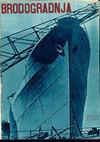钢浮筒在近场爆炸载荷作用下的损伤特性及防护结构设计研究
IF 4.2
4区 工程技术
Q1 ENGINEERING, MARINE
引用次数: 0
摘要
本文的重点是研究浮筒作为港口保护的重要屏障的损伤特征和保护结构设计。研究了浮筒的两种保护措施:向储罐注水和在储罐中安装弹簧。本文采用LS-DYNA显式动力分析软件和ALE算法,模拟了两种类型浮筒边结构在近场爆炸载荷作用下的损伤特性。根据侧箱充入不同体积水的数值实验结果,壳板最小变形的水量为100%,第一个纵向舱壁的水量为30-40%。此外,根据壳板和第一纵向舱壁的实际防爆性能要求,通过对其变形施加重量,可以获得具有最佳防爆性能的浮筒侧结构。配备不同类型弹簧的浮筒结构的塑性变形比普通结构和正水箱中充满水介质的浮筒结构小一个数量级。浮筒吸收的爆炸冲击波能量通过在保护罐中添加水或弹簧而有效减少。浮筒结构在保护箱内加水时吸收的最小能量为普通结构吸收能量的18.31%,相应的保护箱内加水体积比为100%。侧面保护箱中带有弹簧的浮筒结构仅吸收普通结构吸收能量的7.2%。两种新型侧面保护结构均表现出优异的防爆性能。本文章由计算机程序翻译,如有差异,请以英文原文为准。
RESEARCH ON DAMAGE CHARACTERISTICS AND PROTECTIVE STRUCTURE DESIGN OF STEEL PONTOONS UNDER NEAR-FIELD EXPLOSION LOAD
The focus of this paper is to investigate the damage characteristics and protective structure design of pontoons as an important barrier for the protection of ports. Two types of protective measures of pontoons are investigated:filling tanks with water and installing springs in tanks. In this paper, the damage characteristics of two types of pontoon side structures under the action of near-field explosion loads are simulated by using LS-DYNA explicit dynamic analysis software and the ALE algorithm. According to the numerical experiment results for filling different volumes of water in the side tanks, the volume of water for the minimum deformation of the shell plate is 100%, and for the first longitudinal bulkhead, it is 30-40%. Moreover, by applying weights to their deformations based on the actual explosion-proof performance requirements of the shell plate and the first longitudinal bulkhead, the pontoon side structure with the best explosion-proof performance can be obtained. The plastic deformation of the pontoon structure equipped with different types of springs is an order of magnitude smaller than that of the ordinary structure and of the pontoon structure filled with a water medium in the positive tanks. The explosive shock wave energy absorbed by the pontoon is effectively reduced by the addition of water or springs to the protective tanks. The minimum energy absorbed by the pontoon structure with water added in the protective tanks is 18.31% of the energy absorbed by the ordinary structure, and the corresponding volume ratio of water added in the protective tanks is 100%. The pontoon structure with springs in the side protection tanks absorbs only 7.2% of the energy absorbed by the ordinary structure. Both new side protection structures have demonstrated excellent explosion-proof performance.
求助全文
通过发布文献求助,成功后即可免费获取论文全文。
去求助
来源期刊

Brodogradnja
ENGINEERING, MARINE-
CiteScore
4.30
自引率
38.90%
发文量
33
审稿时长
>12 weeks
期刊介绍:
The journal is devoted to multidisciplinary researches in the fields of theoretical and experimental naval architecture and oceanology as well as to challenging problems in shipbuilding as well shipping, offshore and related shipbuilding industries worldwide. The aim of the journal is to integrate technical interests in shipbuilding, ocean engineering, sea and ocean shipping, inland navigation and intermodal transportation as well as environmental issues, overall safety, objects for wind, marine and hydrokinetic renewable energy production and sustainable transportation development at seas, oceans and inland waterways in relations to shipbuilding and naval architecture. The journal focuses on hydrodynamics, structures, reliability, materials, construction, design, optimization, production engineering, building and organization of building, project management, repair and maintenance planning, information systems in shipyards, quality assurance as well as outfitting, powering, autonomous marine vehicles, power plants and equipment onboard. Brodogradnja publishes original scientific papers, review papers, preliminary communications and important professional papers relevant in engineering and technology.
 求助内容:
求助内容: 应助结果提醒方式:
应助结果提醒方式:


